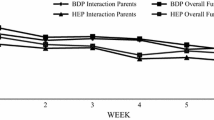Abstract
This study examined patterns and predictors of 79 public sector therapists’ practice element (PE) intentions for treating hypothetical single problem area youth with either anxiety or disruptive behavior problems. Analyses of intention profiles suggested that PE intentions varied by diagnosis and included both a majority of practices derived from the evidence base (PDEBs) and a large number of practices with minimal evidence support (PMESs) for each problem area. Hierarchical multiple regression results indicated the only significant predictor of higher PDEB intentions for both problem areas was reporting more PMES intentions. Implications for community-based research and implementation efforts are discussed.


Similar content being viewed by others
Notes
With regards to the nested nature of this data (i.e., therapists nested within agencies), the authors unfortunately could not statistically account for this in the main analyses described below. Specifically, there was a wide range of therapist participants recruited from each agency, ranging from only two participants at some agencies to up to 15 at others, making it difficult to truly compare group differences. To statistically explore this, however, we ran an ANOVA on the major dependent variable (i.e., PDEB score) for the ANX and DBP scenarios between the 11 agencies and both ANOVAs were nonsignificant.
References
Aarons, G. A. (2004). Mental health provider attitudes toward adoption of evidence-based practice: The Evidence-Based Practice Attitude Scale (EBPAS). Mental Health Services Research, 6(2), 61–74. https://doi.org/10.1007/s10488-010-0327-7.
Ajzen, I. (1991). The theory of planned behavior. Organizational Behavior and Human Decision Processes, 50, 179–211. https://doi.org/10.1016/0749-5978(91)90020-T.
Ajzen, I. (2006). Constructing a theory of planned behavior questionnaire: Conceptual and methodological considerations. https://people.umass.edu/aizen/pdf/tpb.measurement.pdf.
Baumann, B. L., Kolko, D. J., Collins, K., & Herschell, A. D. (2006). Understanding practitioners’ characteristics and perspectives prior to the dissemination of an evidence-based intervention. Child Abuse & Neglect, 30(7), 771–787. https://doi.org/10.1016/j.chiabu.2006.01.002.
Becker, E. M., Smith, A. M., & Jensen-Doss, A. (2013). Who's using treatment manuals? A national survey of practicing therapists. Behaviour Research and Therapy, 51(10), 706–710. https://doi.org/10.1016/j.brat.2013.07.008.
Borntrager, C. F., Chorpita, B. F., Orimoto, T., Love, A., & Mueller, C. W. (2015). Validity of clinician’s self-reported practice elements on the monthly treatment and progress summary. Journal of Behavioral Health Services & Research, 42(3), 367–382. https://doi.org/10.1007/s11414-013-9363-x.
Brookman-Frazee, L., Haine, R. A., Baker-Ericzén, M., Zoffness, R., & Garland, A. F. (2010). Factors associated with use of evidence-based practice strategies in usual care youth psychotherapy. Administration and Policy in Mental Health and Mental Health Services Research, 37(3), 254–269. https://doi.org/10.1007/s10488-009-0244-9.
Burgess, A. M., Chang, J., Nakamura, B. J., Izmirian, S., & Okamura, K. H. (2017). Evidence-based practice implementation within a theory of planned behavior framework. Journal of Behavioral Health Services & Research, 44(4), 647–665. https://doi.org/10.1007/s11414-016-9523-x.
Child and Adolescent Mental Health Division (CAMHD). (2005). Service provider monthly treatment and progress summary. Honolulu, HI: Child and Adolescent Mental Health Division, Hawai’i Department of Health
Chorpita, B. F., & Daleiden, E. L. (2007). 2007 Biennial report: Effective psychosocial interventions for youth with behavioral and emotional needs. Honolulu, HI: Child and Adolescent Mental Health Division, Hawai’i Department of Health.
Chorpita, B. F., & Daleiden, E. L. (2009). Mapping evidence-based treatments for children and adolescents: Application of the distillation and matching model to 615 treatments from 322 randomized trials. Journal of Consulting and Clinical Psychology, 77(3), 566. https://doi.org/10.1037/a0014565.
Cicchetti, D. V. (1994). Guidelines, criteria, and rules of thumb for evaluating normed and standardized assessment instruments in psychology. Psychological Assessment, 6(4), 284. https://doi.org/10.1037/1040-3590.6.4.284.
Daleiden, E. L., & Chorpita, B. F. (2005). From data to wisdom: Quality improvement strategies supporting large-scale implementation of evidence-based services. Child and Adolescent Psychiatric Clinics, 14(2), 329–349. https://doi.org/10.1016/j.chc.2004.11.002.
Daleiden, E. L., Lee, J., & Tolman, R. (2004). Annual report. Honolulu, HI: Child and Adolescent Mental Health Division, Hawai‘i Department of Health.
Eccles, M. P., Hrisos, S., Francis, J., Kaner, E. F., Dickinson, H. O., Beyer, F., et al. (2006). Do self-reported intentions predict clinicians’ behaviour: A systematic review. Implementation Science, 1, 28. https://doi.org/10.1186/1748-5908-1-28.
Foy, R., Bamford, C., Francis, J. J., Johnston, M., Lecouturier, J., Eccles, M., et al. (2007). Which factors explain variation in intention to disclose a diagnosis of dementia? A theory-based survey of mental health professionals. Implementation Science, 2, 31. Retrieved from https://www.implementationscience.com/content/2/1/31.
Francis, J. J., Eccles, M. P., Johnston, M., Walker, A., Grimshaw, J., Foy, R., Bonetti, D. (2004). Constructing questionnaires based on the theory of planned behavior: A manual for health services researchers. Newcastle upon Tyne, UK: Centre for Health Services Research, University of Newcastle upon Tyne. Retrieved from https://openaccess.city.ac.uk/1735/.
Garland, A. F., Bickman, L., & Chorpita, B. F. (2010a). Change what? Identifying quality improvement targets by investigating usual mental health care. Administration and Policy in Mental Health and Mental Health Services Research, 37, 15–26. https://doi.org/10.1007/s10488-010-0279-y.
Garland, A. F., Hurlburt, M. S., Brookman-Frazee, L., Taylor, R. M., & Accurso, E. C. (2010b). Methodological challenges of characterizing usual care psychotherapeutic practice. Administration and Policy in Mental Health and Mental Health Services Research, 37(3), 208–220. https://doi.org/10.1007/s10488-009-0237-8.
Godin, G., Bélanger-Gravel, A., Eccles, M., & Grimshaw, J. (2008). Healthcare professionals’ intentions and behaviours: A systematic review of studies based on social cognitive theories. Implementation Science, 3, 36. https://doi.org/10.1186/1748-5908-3-36.
Higa-McMillan, C. K., Nakamura, B. J., Morris, A., Jackson, D. S., & Slavin, L. (2015). Predictors of use of evidence-based practices for children and adolescents in usual care. Administrative Policy in Mental Health, 42(4), 373–383. https://doi.org/10.1007/s10488-014-0578-9.
Hurlburt, M. S., Garland, A. F., Nguyen, K., & Brookman-Frazee, L. (2010). Child and family therapy process: Concordance of therapist and observational perspectives. Administration and Policy in Mental Health and Mental Health Services Research, 37(3), 230–244. https://doi.org/10.1007/s10488-009-0251-x.
Izmirian, S., Chang, J. P., & Nakamura, B. N. (2019). Predicting youth improvement in community-based residential settings with practices derived from the evidence-base. Administration and Policy in Mental Health and Mental Health Services Research, 46(4), 458–476. https://doi.org/10.1007/s10488-019-00925-2
Izmirian, S. C., Nakamura, B. J., Hill, K. A., Higa-McMillan, C. K., & Slavin, L. (2016). Therapists’ knowledge of practice elements derived from the evidence-base: Misconceptions, accuracies, and guidance of future training efforts. Professional Psychology: Research and Practice, 47(3), 181–191. https://doi.org/10.1037/pro0000081.
Kazdin, A. E. (1995). Child, parent and family dysfunction as predictors of outcome in cognitive-behavioral treatment of antisocial children. Behaviour Research and Therapy, 33, 271–281. https://doi.org/10.1016/0005-7967(94)00053-M.
Keir, S., Jackson, D., Mueller, C., & Okado, I. (2016). Child and adolescent mental health division: 2015 annual factbook. Honolulu, HI: CAMHD.
Kelly, P. J., Deane, F. P., & Lovett, M. J. (2012). Using the theory of planned behavior to examine residential substance abuse workers intention to use evidence-based practices. Psychology of Addictive Behaviors, 26(3), 661–664. https://doi.org/10.1037/a0027887.
Love, A. R., Okado, I., Orimoto, T. E., & Mueller, C. W. (2018). Factor analysis of therapist-identified treatment targets in community-based children’s mental health. Administration and Policy in Mental Health and Mental Health Services Research, 45(1), 103–120. https://doi.org/10.1007/s10488-016-0770-1.
Lynn, M. R. (1986). Determination and quantification of content validity. Nursing Research, 35(6), 382–386. https://doi.org/10.1097/00006199-198611000-00017.
Mah, A. C., Hill, K. A., Cicero, D. C., & Nakamura, B. J. (in press). A psychometric evaluation of the intention scale for providers – Direct items. Journal of Behavioral Health Services and Research. https://doi.org/10.1007/s11414-019-09675-3.
McLeod, B. D., & Weisz, J. R. (2010). The therapy process observational coding system for child psychotherapy strategies scale. Journal of Clinical Child & Adolescent Psychology, 39(3), 436–443. https://doi.org/10.1080/15374411003691750.
Milette-Winfree, M., & Mueller, C. W. (2018). Treatment-as-usual therapy targets for comorbid youth disproportionately focus on externalizing problems. Psychological Services, 15(1), 65. https://doi.org/10.1037/ser0000162.
Orimoto, T. E. (2012). Predicting progress ratings for disruptive behavior targets with practices derived from the evidence-base in community mental health services (Publication No. 3691717). [Doctoral dissertation, University of Hawai‘i at Mānoa]. ProQuest Dissertations and Theses Global.
Orimoto, T. E., Mueller, C. W., Hayashi, K., & Nakamura, B. J. (2013). Community-based treatment for youth with co- and multimorbid disruptive behavior disorders. Administration and Policy in Mental Health and Mental Health Services Research, 41, 262–275. https://doi.org/10.1007/s10488-012-0464-2.
PracticeWise, LLC. (2017). PracticeWise evidence-base services database [online database]. Retrieved September 17, 2017, from https://www.practicewise.com.
Schoenberg, N. E. & Ravdal, H. (2000). Using vignettes in awareness and attitudinal research. Social Research Methodology, 3(1), 63–74. https://doi.org/10.1080/136455700294932.
Sheeran, P. (2002). Intention-behavior relations: A conceptual and empirical review. In W. Stroebe & M. Hewstone (Eds.), European review of social psychology (Vol. 12, pp. 1–36). Chichester: Wiley. https://doi.org/10.1002/0470013478.ch1.
Tabachnick, B. J., & Fidell, L. S. (2007). Using multivariate statistics (6th ed.). Needham Heights: Allyn & Bacon.
Ulrich, C. M. & Ratcliffe, S. J. (2008). Hypothetical vignettes in empirical bioethics research. In L. Jacoby & L. A. Siminoff (Eds.) Empirical Methods for Bioethics: A Primer. Advances in Bioethics 11, 161–181. https://doi.org/10.1016/S1479-3709(07)11008-6.
Williams, N. (2016). Assessing mental health clinicians’ intentions to adopt evidence-based treatments: Reliability and validity testing of the evidence-based treatment intentions scale. Implementation Science, 11, 1–13. https://doi.org/10.1186/s13012-016-0417-3.
Wilson, C. P. (1998). Applying the theory of planned behavior to predict and explain school psychologists’ use of the consultation model (Publication No. AAI9908490). [Doctoral dissertation, University of Nebraska – Lincoln]. ProQuest Dissertations and Theses Global.
Acknowledgements
This research team would like to acknowledge Drs. Charles W. Mueller and David Cicero for their participation in the design and review of this study. Additionally, this study would not have been possible without the support from the staff and contracted providers with the Child and Adolescent Mental Health Division of the State of Hawai’i Department of Health and the help of the expert team of faculty, graduate students, and research assistants working in our lab.
Funding
This work was supported by the University of Hawai’i at Mānoa Department of Psychology’s Gartley Graduate Student Research Award awarded to Kaitlin A. Hill.
Author information
Authors and Affiliations
Corresponding author
Ethics declarations
APA ethical standards were followed in the conduct of this study.
Conflict of interest
The authors declare they have no conflict of interest.
Ethical Approval
All procedures performed in this study involving human participants were in accordance with the ethical standards of the institutional and/or national research committee and with the 1964 Helsinki declaration and its later amendments or comparable ethical standards.
Informed Consent
Informed consent was obtained from all individual participants included in the study.
Additional information
Publisher's Note
Springer Nature remains neutral with regard to jurisdictional claims in published maps and institutional affiliations.
Rights and permissions
About this article
Cite this article
Hill, K.A., Mah, A.C. & Nakamura, B.J. Where Does It Begin? Community-Based Therapists’ Intentions for Treating Non-comorbid Youth. Adm Policy Ment Health 48, 106–120 (2021). https://doi.org/10.1007/s10488-020-01051-0
Published:
Issue Date:
DOI: https://doi.org/10.1007/s10488-020-01051-0




